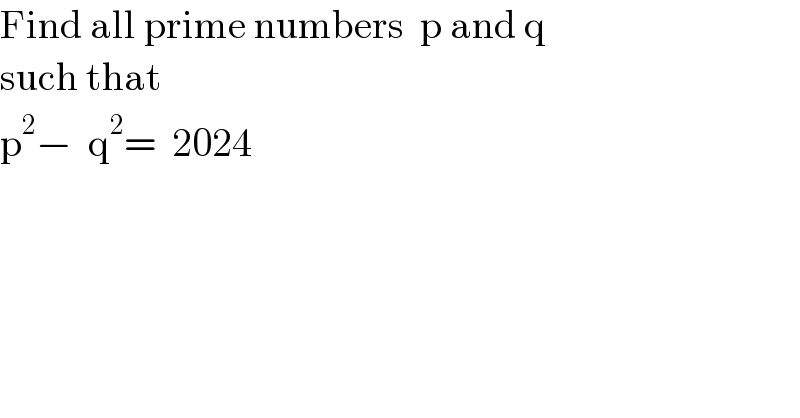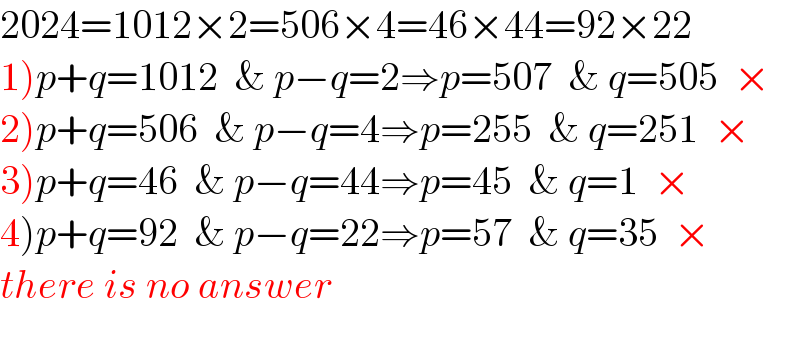
Question Number 216995 by Rasheed.Sindhi last updated on 26/Feb/25

$$\mathrm{Find}\:\mathrm{all}\:\mathrm{prime}\:\mathrm{numbers}\:\:\mathrm{p}\:\mathrm{and}\:\mathrm{q}\: \\ $$$$\mathrm{such}\:\mathrm{that} \\ $$$$\mathrm{p}^{\mathrm{2}} −\:\:\mathrm{q}^{\mathrm{2}} =\:\:\mathrm{2024} \\ $$
Answered by Marzuk last updated on 26/Feb/25

$$ \\ $$$$\left({p}+{q}\right)\left({p}−{q}\right)=\mathrm{2024} \\ $$$$\mathrm{2024}\:=\:\mathrm{2}×\mathrm{1012} \\ $$$$\:\:\:\:\:\:\:\:\:\:\:=\:\mathrm{4}×\mathrm{506} \\ $$$$\:\:\:\:\:\:\:\:\:\:\:=\mathrm{8}×\:\mathrm{253} \\ $$$$\:\:\:\:\:\:\:\:\:\:\:=\mathrm{88}×\mathrm{23} \\ $$$$\:\:\:\:\:\:\:\:\:\:\:=\mathrm{1}×\mathrm{2024} \\ $$$$\:\:\:\:\:\:\:\:\:\:\:=\mathrm{22}×\mathrm{92} \\ $$$$\:\:\:\:\:\:\:\:\:\:\:=\mathrm{11}×\mathrm{184} \\ $$$$\:\:\:\:\:\:\:\:\:\:\:=\mathrm{44}×\mathrm{46} \\ $$$${p}+{q}+{p}−{q}=\mathrm{2}{p} \\ $$$${that}\:{means}\:{sum}\:{of}\:{the}\:{each}\:{pair}\:{has} \\ $$$${to}\:{be}\:{divisible}\:{by}\:\mathrm{2} \\ $$$$\mathrm{2}+\mathrm{1012}=\mathrm{1014} \\ $$$$\mathrm{4}+\mathrm{506}=\mathrm{510} \\ $$$$\mathrm{8}+\mathrm{253}=\mathrm{261} \\ $$$$\mathrm{88}+\mathrm{23}=\mathrm{111} \\ $$$$\mathrm{1}+\mathrm{2024}=\mathrm{2025} \\ $$$$\mathrm{22}+\mathrm{92}=\mathrm{114} \\ $$$$\mathrm{11}+\mathrm{184}=\mathrm{195} \\ $$$$\mathrm{44}+\mathrm{46}=\mathrm{90} \\ $$$${so}\:{we}\:{have}\:{left}\:\mathrm{4}\:{pairs} \\ $$$$\mathrm{2}×\mathrm{1012} \\ $$$$\mathrm{4}×\mathrm{506} \\ $$$$\mathrm{22}×\mathrm{92} \\ $$$$\mathrm{44}×\mathrm{46} \\ $$$${lets}\:{see}\:{if}\:{the}\:{dividend}\:{is}\:{the}\:{sumof}\:{each} \\ $$$${pair}\:{and}\:{the}\:{divisor}\:{is}\:\mathrm{2}\:{then}\:{the}\:{quotient} \\ $$$${is}\:\in\:\mathbb{P} \\ $$$$\frac{\Sigma\left(\mathrm{2},\mathrm{1012}\right)}{\mathrm{2}}\:\:\notin\:\mathbb{P} \\ $$$$\frac{\Sigma\left(\mathrm{4},\mathrm{506}\right)}{\mathrm{2}}\:\notin\:\mathbb{P} \\ $$$$\frac{\Sigma\left(\mathrm{22},\mathrm{92}\right)}{\mathrm{2}}\:\notin\:\mathbb{P} \\ $$$$\frac{\Sigma\left(\mathrm{44},\mathrm{46}\right)}{\mathrm{2}}\:\notin\:\mathbb{P}\: \\ $$$${So},{the}\:{set}\:{of}\:{all}\:{possible}\:{prime}\:{values}\:{of} \\ $$$${is}\:\emptyset\: \\ $$
Commented by Rasheed.Sindhi last updated on 26/Feb/25

$$\mathcal{T}{hanks}\:{sir}! \\ $$
Answered by mehdee7396 last updated on 26/Feb/25

$$\mathrm{2024}=\mathrm{1012}×\mathrm{2}=\mathrm{506}×\mathrm{4}=\mathrm{46}×\mathrm{44}=\mathrm{92}×\mathrm{22} \\ $$$$\left.\mathrm{1}\right){p}+{q}=\mathrm{1012}\:\:\&\:{p}−{q}=\mathrm{2}\Rightarrow{p}=\mathrm{507}\:\:\&\:{q}=\mathrm{505}\:\:× \\ $$$$\left.\mathrm{2}\right){p}+{q}=\mathrm{506}\:\:\&\:{p}−{q}=\mathrm{4}\Rightarrow{p}=\mathrm{255}\:\:\&\:{q}=\mathrm{251}\:\:× \\ $$$$\left.\mathrm{3}\right){p}+{q}=\mathrm{46}\:\:\&\:{p}−{q}=\mathrm{44}\Rightarrow{p}=\mathrm{45}\:\:\&\:{q}=\mathrm{1}\:\:× \\ $$$$\left.\mathrm{4}\right){p}+{q}=\mathrm{92}\:\:\&\:{p}−{q}=\mathrm{22}\Rightarrow{p}=\mathrm{57}\:\:\&\:{q}=\mathrm{35}\:\:× \\ $$$${there}\:{is}\:{no}\:{answer} \\ $$$$\: \\ $$
Commented by Rasheed.Sindhi last updated on 26/Feb/25

$$\mathbb{T}\mathrm{hanx}\:\mathrm{sir}! \\ $$
Answered by MathematicalUser2357 last updated on 01/Mar/25

$$\mathrm{can}'\mathrm{t}\:\mathrm{find}\:\mathrm{all}\:\mathrm{prime}\:\mathrm{numbers}\:{p}\:\mathrm{and}\:{q}\:\mathrm{because}\:\mathrm{I}\:\mathrm{tried}\:\mathrm{to}\:\mathrm{find}\:\mathrm{it}! \\ $$
